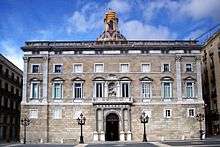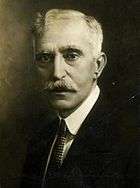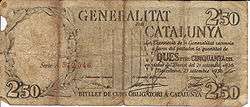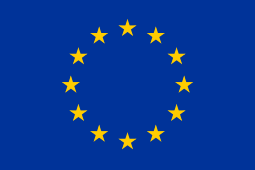Generalitat de Catalunya
The Generalitat de Catalunya (Catalan pronunciation: [ʒənəɾəliˈtad də kətəˈluɲə]; in Spanish: Generalidad de Cataluña; in Aranese: Generalitat de Catalonha), or Government of Catalonia, is the institutional system by which Catalonia politically organizes its self-government. It is formed by the Parliament of Catalonia, the Presidency of the Generalitat de Catalunya, and the Executive Council of Catalonia (also very often referred to as "Govern", which means Government, but can not take decisions alone)
 Seal of the Generalitat de Catalunya | |
 Logo of the Generalitat de Catalunya | |
| Government of Catalonia overview | |
|---|---|
| Formed | 1359 (first inception) 1931 (established by the Second Spanish Republic) 1977 (reestablished from exile) |
| Dissolved | 11 September 1714 (Nueva Planta Decrees) 5 February 1939 (Francoist occupation during Spanish Civil War) |
| Jurisdiction | |
| Headquarters | Palau de la Generalitat de Catalunya |
| Employees | 240,000[1] |
| Annual budget | €34.03 billion (2017)[2] |
| Government of Catalonia executives |
|
| Website | gencat.cat |
Its origins are in the 13th century when permanent councils were created to rule administration of the Courts of the different territories and Kingdoms that formed the Crown of Aragon which gave birth to the General Council of the Principality of Catalonia (1359), the General Council of the Kingdom of Aragon (1362) and the General Council of the Kingdom of Valencia (1412).
Its headquarters are at the Palau de la Generalitat, in the city of Barcelona.
History
The Generalitat of Catalonia finds its origins in the Catalan Courts, as during the reign of James I the Conqueror (1208-1276) they reunited and were convoked by the king, as representatives of the social statements of the time. Under the reign of Peter the Great (1276-1285), the Catalan Courts gained institutional status, after the king obliged himself to celebrate an annual "General Court".
The Catalan Courts exercised as Council and had legislative functions through its three branches: the ecclesiastical (clergy), the military (nobility) and the popular (villages and towns submitted to direct rule of the king). This union of powers was named "Lo General de Cathalunya"
Is in 1289 when the first step into becoming an institution happens during the Courts celebrated in the castle of Montsó (situated in the Kingdom of Aragon, ruled by Count of Barcelona, since the year 1151 AD when Count Ramon Berenguer IV married Princess Petronilla of Aragon[3]). A commission was then designed as "Diputació del General" (General Deputation)[4][5], as to temporarily collect the "services" or tributes that the "branches" granted the king on his demand. This tax was popularly known as "Drets Generals" (General Rights) or "generalitats" (generalities), finding its counterpart in the French "Généralités", which were also founded as taxing districts.
Medieval origins


Catalonia's political past as a territorially differentiated community with its own representative and separated institutions, with respect to the sovereign power of the combined Catalan counties (988-1164), the Crown of Aragon (1164-1516), the Monarchy of Spain (1516-1808),(1812-1814) French Empire and of the Spanish constitutional state (since 1814), can be divided into four stages, separated by three great ruptures in the legal/public order.
The Pau i Treva de Déu ("Peace and Truce of God") was a social movement born in the eleventh century promoted by the Church, united with the peasantry as the response to the violence perpetrated by feudal nobles. The hometowns, then, delimited a space protected of feudal violence. However, to ensure a coexistence climate, it was necessary to go further, establishing an authority that prohibited the practice of any type of violent act anywhere in the territory. This was the objective of the assemblies of Peace and Truce of God, the first of which, in the Catalan counties, took place in Toluges (Roussillon), in 1027, under the presidency of Abbot Oliba, on behalf of Bishop Berenguer d'Elna, absent from the diocese because he was on a pilgrimage. The origin of the Catalan Courts can be considered from the Peace of Truce of God.
The Generalitat of Catalonia stems from the medieval institution which ruled, in the name of the King of the Crown of Aragon, some aspects of the administration of the Principality of Catalonia. The Catalan Courts were the main institution of the Principality during its existence as a political entity and approved the Catalan constitutions. The first constitutions were that of the Courts of 1283.[6]
The medieval precedent of the Generalitat, the Diputació del General de Catalunya ("Deputation of the General of Catalonia", where "General" means the political community of the Catalans and not the military rank) was a permanent council of deputies established by the Courts in order to recapt the new "tax of the General" in 1359, and gained an important political power during the next centuries, assuming tasks of prosecutor. It was chosen by the legislators in 1931 because they felt it was appropriate for invoking as a legitimising base for contemporary self-government.
First abolition
Catalan institutions which depended on the Generalitat were abolished in what is currently known in Catalonia as Northern Catalonia, one year after the signature of the Treaty of the Pyrenees in the 17th century, which transferred the territory from Spanish to French sovereignty.
Then, by the early 18th century, as the "Nueva Planta Decrees" were passed in Spain after the Catalan defeat in the War of the Spanish Succession, the institution was abolished in the Spanish territory as well.
First restoration


The Generalitat was restored in the Catalonia under Spanish administration in 1931 during the events of the proclamation of the Second Spanish Republic when Francesc Macià, leader of the Republican Left of Catalonia, declared the Catalan Republic on 14 April but later reached an agreement with the Spanish ministers, in which the Catalan Republic was renamed Generalitat of Catalonia (Catalan: Generalitat de Catalunya) and given its modern political and representative function as the autonomous government of Catalonia within the Spanish Republic.[7] The restored Generalitat was ruled by a statute of autonomy approved by the Spanish Cortes and included a parliament, a presidency, a government and a court of appeal. It was presided by Francesc Macià (1931-1933) and Lluís Companys (1933-1940).
After the right wing coalition won the Spanish elections in 1934, the leftist leaders of the Generalitat of Catalonia rebelled in October of that year against the Spanish authorities, and it was temporarily suspended from 1934 to 1936.
Second abolition

In 1939, as the Spanish Civil War finished with the defeat of the Republican side, the Generalitat of Catalonia as an institution was abolished and remained so during the Francoist dictatorship until 1975. The president of the Generalitat at the time, Lluís Companys, was tortured and executed in October 1940 for the crime of 'military rebellion'. Nonetheless, the Generalitat maintained its official existence in exile, led by presidents Josep Irla (1940-1954) and Josep Tarradellas (1954-1980).
Second restoration
The succession of presidents of the Generalitat was maintained in exile from 1939 to 1977, when Josep Tarradellas returned to Catalonia and was recognized as the legitimate president by the Spanish government. Tarradellas, when he returned to Catalonia, made his often quoted remark "Ciutadans de Catalunya: ja sóc aquí" ("Citizens of Catalonia: I am back!"), reassuming the autonomous powers of Catalonia, one of the historic nationalities of present-day Spain.
After this, the powers given to the autonomous Catalan government according to the Spanish Constitution of 1978 were transferred and the Statute of Autonomy of Catalonia (Estatut d'Autonomia) was passed after being approved both by referendum in Catalonia and by the Spanish parliament.
Recent history
Governance since 2006
Artur Mas held the office of President of the Generalitat from December 2010[8] until his resignation in January 2016,[9] leading a minority government dependent on pacts with other parties including the Socialists' Party of Catalonia following the 2010 election and the 2015 election.
José Montilla, leader of the Socialist Party, had been the president of the Generalitat until November 2010, he was backed up by a tripartite coalition of left-wing and Catalan nationalist political parties. His party actually won fewer seats in parliament than the main opposition party, Convergence and Union, in the 2006 election, but as he gathered more support from MPs from other parties in the parliament, he was able to repeat the same coalition government that his predecessor (Pasqual Maragall) had formed in order to send CiU to the opposition for the first time after 23 years of Jordi Pujol's government.
On 18 June 2006, a reformed version was approved of the Statute of Autonomy of Catalonia and went into effect in August. In its inception, the reform was promoted by both the leftist parties in the government and by the main opposition party (CiU), which were united in pushing for increased devolution of powers from the Spanish government level, enhanced fiscal autonomy and finances, and explicit recognition of Catalonia's national identity; however the details of its final redaction were harshly fought and the subject became a controversial issue in the Catalan politics, with ERC, themselves members of the Tripartite, finally opposing it. In 2010, the Spanish Constitutional Court reduced the Statute voted in a referendum, eliminating or reinterpreting more than 200 articles, due to a signature collection promoted by then the Spanish opposition leader, Mariano Rajoy. Tis is considered one of the main reasons for the independence boom that happened from 2010 with 8% support to 2018 with 52.4% Support.
Former president Artur Mas (mentioned above) was recently charged by the Spanish government for civil disobedience, after he organised and staged a referendum on independence in 2014.[10]
Current status
The most recent President of the Generalitat of Catalonia was Carles Puigdemont, member of the Catalan European Democratic Party,[11] successor formation to the defunct Convergence and Union alliance.[12] He was suspended from office on 27 October 2017, by the Spanish government.[13][14]
After a number of attempts to invest a new president, Quim Torra became president on the 17th of May 2018, with Junts per Catalunya and Republican Left of Catalonia voting in favour of him.
Autonomous system of government
 |
|---|
| This article is part of a series on the politics and government of Catalonia |
|
Statutes and constitutions
|
|
|
Executive Council
|
|
Parliament
|
|
Judiciary
|
|
Public order
|
|
Political parties Parliamentary parties:
|
|
Elections
|
|
Divisions
|
|
The autonomous government consists of the Executive Council, the President and the Parliament. Some people wrongly apply this name only to the executive council (the cabinet of the autonomous government); however, Generalitat de Catalunya is the system of Catalan autonomous government as a whole.
The region has gradually achieved a greater degree of autonomy since 1979. After Navarre and the Basque Country regions, Catalonia has the greatest level of self-government in Spain. When it is fully instated, the Generalitat holds exclusive and wide jurisdiction in various matters of culture, environment, communications, transportation, commerce, public safety and local governments.[15] In many aspects relating to education, health and justice, the region shares jurisdiction with the Spanish government.[16]
One of the examples of Catalonia's degree of autonomy is its own police force, the Mossos d'Esquadra ("Troopers"), which has taken over most of the police functions in Catalonia which used to be served by the Civil Guard (Guardia Civil) and the Spanish National Police Corps.
With few exceptions, most of the justice system is administered by national judicial institutions. The legal system is uniform throughout the Spanish state, with the exception of some parts of civil law – especially family, inheritance, and real estate law – that have traditionally been ruled by so-called foral law.[17] The fields of civil law that are subject to autonomous legislation have been codified in the Civil Code of Catalonia (Codi civil de Catalunya) consisting of six books that have successively entered into force since 2003.[18]
Another institution stemming from the Catalan autonomy statute, but independent from the Generalitat in its check and balance functions, is the Síndic de Greuges (ombudsman)[19] to address problems that may arise between private citizens or organizations and the Generalitat or local governments.
Legislature
The Parliament of Catalonia (in Catalan: Parlament de Catalunya) is the legislative body of the Generalitat and represents the citizens of Catalonia. It is elected every four years by universal suffrage, and it has powers to legislate in different matters such as education, health, culture, internal institutional and territorial organization, election and control of the president of the Generalitat and the Government, budget and others, according with the Statute of Autonomy. The last Catalan election was held on 21 December 2017, and its current president is Roger Torrent, incumbent since January 2018.
Presidency
The president of the Generalitat of Catalonia (in Catalan: president de la Generalitat de Catalunya) is the highest representative of Catalonia, and is also responsible of leading the government's action. Since the restoration of the Generalitat on the return of democracy in Spain, the presidents of Catalonia have been Josep Tarradellas (1977–1980, president in exile since 1954), Jordi Pujol (1980–2003), Pasqual Maragall (2003–2006), José Montilla (2006–2010), Artur Mas (2010–2016), Carles Puigdemont (2016–2017) and, after the imposition of direct rule from Madrid, Quim Torra (2018–).
Executive

The Executive Council (in Catalan: Consell Executiu) or Government (Govern), is the body responsible of the government of the Generalitat, it holds executive and regulatory power. It comprises the president of the Generalitat, the First Minister (or the Vice President) and the Ministers (consellers). Its seat is the Palau de la Generalitat, in Barcelona.
International presence
As an autonomous community of Spain, Catalonia is not recognized as a sovereign state by any sovereign state. However, as Catalonia has progressively gained a greater degree of self-government in recent years, the Catalan Government has established nearly bilateral relationships with foreign bodies. For the most part, these relationships are with the governments of other powerful subnational entities such as Quebec[20] or California.[21] In addition, like most Spanish autonomous communities, Catalonia has permanent delegations before international organizations, such as the European Union.[22]
More recently, Catalonia has embarked upon an expansion process of its international representation by opening a number of delegations worldwide. As of 2017, these exceeded 40.[23][24] Most of these offices are located in major world cities like London, New York City, Los Angeles, Paris, Tokyo and others. Each office has specific duties assigned by their ministry or department agency. Generally, the functions of these are the representation of specific interests of the Government of Catalonia, trade and foreign investment, Catalan culture and language support, tourist promotion and international cooperation activities.[24][25]
There are no specific Catalan political institutions in Northern Catalonia, other than the French département of Pyrénées-Orientales. However, since 5 September 2003, there has been a Casa de la Generalitat in Perpignan, which aims to promote the Catalan culture and facilitate exchanges between each side of the Franco–Spanish border.[26]
Under application of article 155 of the Constitution following the constitutional crisis of 2017 Catalonia only had 1 delegation abroad, after the rest were closed, this delegation was the one of Brussels, Belgium. The Catalan Government elected after 21 December election is in process to restore the closed delegations.
This is the list of the current delegations of the Generalitat of Catalonia abroad:
.svg.png)












See also
- 2017–18 Spanish constitutional crisis
- Catalonia Government 2006-2010 term of office
- Commonwealth of Catalonia
- List of Presidents of the Generalitat de Catalunya
Notes
- Statistical Bulletin of public administrations, P.32 Archived 26 November 2012 at the Wayback Machine
- http://aplicacions.economia.gencat.cat/wpres/AppPHP/2017/pdf/VOL_L_EID.pdf
- Petronilla of Aragon
- Constitutions y altres drets de Cathalunya compilats en virtut del cap. de Cort XXIIII de las Corts per la S. C. y reyal maiestat del rey don Philip nostre senyor celebradas en la villa de Montso any MDLXXXV: volum primer (in Catalan). en casa de Hubert Gotart. 1588.
- "Diputació del General de Catalunya", Viquipèdia, l'enciclopèdia lliure (in Catalan), 2019-11-06, retrieved 2020-01-05
- "Google Translate". translate.google.com. Retrieved 2019-07-11.
- Carr, Raymond. Modern Spain: 1975-1980. Oxford University Press, 1980, p.xvi.
- "Real Decreto 1777/2010" (PDF). Boletín Oficial del Estado.
- "BOE.es - Documento BOE-A-2016-276". www.boe.es (in Spanish). Retrieved 2017-09-08.
- "SOCIALISTS, LEFTISTS RECONSTITUTE THREE PARTY COALITION, OUTLINE NEW CATALAN GOVERNMENT". 2010-12-16. Archived from the original on 2013-05-11. Retrieved 2010-12-18.
- "Comitè Nacional". Partit Demòcrata (in Catalan). Archived from the original on 2017-09-09. Retrieved 2017-09-08.
- "Transparència". Partit Demòcrata (in Catalan). Archived from the original on 2017-09-09. Retrieved 2017-09-08.
- Real Decreto 942/2017, de 27 de octubre, por el que se dispone, en virtud de las medidas autorizadas con fecha 27 de octubre de 2017 por el Pleno del Senado respecto de la Generalitat de Cataluña en aplicación del artículo 155 de la Constitución, el cese del M.H. Sr. Presidente de la Generalitat de Cataluña, don Carles Puigdemont i Casamajó. Boletin Oficial del Estado núm. 261, de 28 de octubre de 2017, páginas 103562 a 103563
- "BOE.es - Documento BOE-A-2016-277". www.boe.es (in Spanish). Retrieved 2017-09-08.
- "Archived copy". Archived from the original on 2005-12-16. Retrieved 2006-06-19.CS1 maint: archived copy as title (link)
- "Archived copy". Archived from the original on 2005-12-30. Retrieved 2006-06-19.CS1 maint: archived copy as title (link)
- García Cantero, Gabriel (2013). Is It Possible for a Minor Code of the Nineteenth Century to Serve as a Model in the Twenty-First Century. The Scope and Structure of Civil Codes. Springer. p. 372.
- de Gispert i Català, Núria (2003). The codification of Catalan civil law. Regional Private Laws and Codification in Europe. Cambridge University Press. pp. 164–171.
- "Archived copy". Archived from the original on 2006-04-08. Retrieved 2019-12-25.CS1 maint: archived copy as title (link)
- http://www.mdeie.gouv.qc.ca/index.php?id=4201%5B%5D
- "Senate Concurrent Resolution No. 71 - Senate Office of International Relations".
- http://www.copca.cat/infoglueDeliverLive/ViewPage.action?siteNodeId=247&languageId=1&contentId=-1%5B%5D
- "Archived copy". Archived from the original on 2011-07-25. Retrieved 2009-08-25.CS1 maint: archived copy as title (link)
- "Archived copy". Archived from the original on 2009-05-18. Retrieved 2009-08-25.CS1 maint: archived copy as title (link)
- "Archived copy". Archived from the original on 2011-07-25. Retrieved 2009-08-25.CS1 maint: archived copy as title (link)
- "Archived copy". Archived from the original on 2011-09-28. Retrieved 2009-08-25.CS1 maint: archived copy as title (link)
References
- Party Urging More Autonomy From Spain Seems to Win in Catalonia Article on New York Times, 2 November 2006
- Courage in Catalonia Article on New York Times, 22 June 2006
- Voters in Catalonia Approve A Plan for Greater Autonomy Article on New York Times, 19 June 2006
- Spain Moves On Law to Give Broad Powers To Catalonia Article on New York Times, 31 March 2006